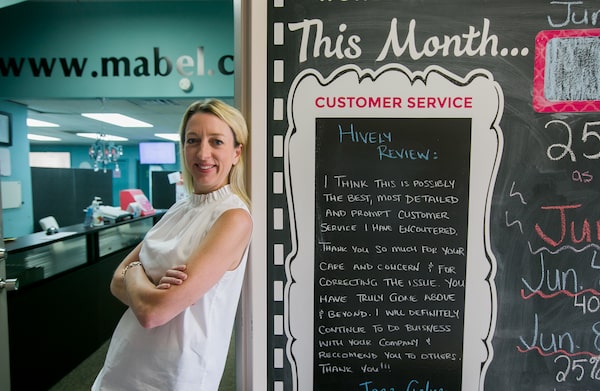
Julie Cole co-founder, senior director public relations at Mabel’s Labels Inc is surrounded by her customer service team who work at keeping customers happy on July 2, 2019 in their Hamilton headquarters.Glenn Lowson
These days, when someone complains about Mabel’s Labels Inc. on social media, the company resolves the issue publicly on the platform, so everyone can see how far it will go for its customers. It’s a strategy that has worked well for the Hamilton-based company, which makes waterproof labels and tags for kids’ belongings, but it only evolved after a public blunder, co-founder Julie Cole says.
“The first time someone complained, years ago, our social media co-ordinator dealt with it with the customer, and then took [the post] down,” Ms. Cole says. “Then somebody said, ‘You guys only allow nice things on your wall.’”
The company realized the choice was between leaving the complaints on its feed for all to see (and responding appropriately) or constantly curating the feed to remove negative comments. They chose the former.
Now they see a complaint as an opportunity.
“We’re glad to get the complaint because it allows us to … do right by the customer,” Ms. Cole says. “They become loyal fans and even stronger brand ambassadors. … We’ve had people say, ‘I am now going to order from you because I saw how you dealt with this customer-service issue.’”
Respond quickly, accept responsibility
While social media makes it easier than ever for customers to complain publicly, marketing experts say many companies don’t always respond to those concerns in a way that reflects well on the business.
Responding quickly, accepting responsibility and finding a solution that works for both sides may seem like common sense, but they are often overlooked in favour of shutting down criticism or providing stock responses — tactics that can turn off the complainant and other potential customers.
“The biggest mistake is to not respond at all,” says Tod Maffin, whose Vancouver-based firm EngageQ Digital Inc. manages social media strategy and communications for organizations including the Grey Cup Festival, OK Tire and several shopping malls across the country. “If you respond poorly, it’s better than ignoring the problem,” he says.
Speed is critical to prevent a complaint from going viral, Mr. Maffin says.
“What used to be an appropriate time, maybe a day, is too long,” he says. “People post something, wait an hour or two, then get mad and share their complaint with their friends. It begins to pick up steam.”

Julie Cole co-founder, senior director public relations at Mabel’s Labels Inc. chats with Andrea Settimi customer service manager.Glenn Lowson/Handout
Be human in your customer interaction
Key to the response is “acting like a human,” which Mr. Maffin says is being understanding and relatable, as opposed to using corporate jargon such as “we appreciate your feedback.”
“Over the last few years, brands are getting better at responding more quickly, but there’s been no improvement on ... getting past the platitudes,” he adds.
Jeanne Bliss, a customer-experience expert based in Seattle, urges business owners to treat clients the way they would their mothers: by listening, offering respect and apologizing for mistakes.
“Immediately admit you made a mistake, whether you have a fix for it or not. Then apologize humbly and find a fix, and unite the organization in finding a fix,” says Ms. Bliss, offering advice from her book, Would You Do That to Your Mother?: The "Make Mom Proud" Standard for How to Treat Your Customers.
Ms. Bliss recommends sharing the solutions across the company to prevent the problem from surfacing again.
She says hiring people with good social and problem-solving skills is essential, but so too is providing a positive work environment and allowing workers the latitude to find solutions themselves.
“You need to hire people differently and enable them to bring the best version of themselves to work,” she says. “Don’t box your people in with rules that inhibit their ability to do the right thing, like forcing them to say no to someone whose warranty is one day expired. Don’t make them ask for permission to do the right thing.”
Providing a good customer experience is critical
Providing top-notch customer service is particularly important for small businesses with numerous competitors, says Doug Stephens, founder of Toronto-area consultancy Retail Prophet. He says consumers choose small businesses expecting advanced knowledge of the product and better service — and will often pay more than they would at a big-box store based on those expectations.
“When those things are not the case, our sense of disappointment is also heightened,” Mr. Stephens says.
A common problem among small businesses is the tendency for owner-operators to take complaints personally, which Mr. Stephens cautions against. In most cases, he says a complaint is not a personal attack. However, if complaints appear to be frequent and similar, it may be time for entrepreneurs to take a look at their own management style.
“It’s not inconceivable that you could be setting the tone for your business, and it’s not a good tone. If the people who work for you are treating customers poorly, you have to ask yourself why," he says.
On rare occasions, the problem really is the customer — the type of person who appears impossible to satisfy, despite numerous offers of redress. In such cases, Mr. Stephens says it makes sense to address the complaints in public.
“Be extremely transparent with the steps and measures you’ve tried to take,” he says. “Post something like, ‘I sense that you are clearly still not satisfied, but just to reiterate, we have invited you to come in to resolve the issue, offered a refund, offered a new product.’… It’s now an effort to show all other reasonable people online that your business is bending over backward.
“If you recognize you have a loose cannon on your hands ... there’s not a heck of a lot you can do.”